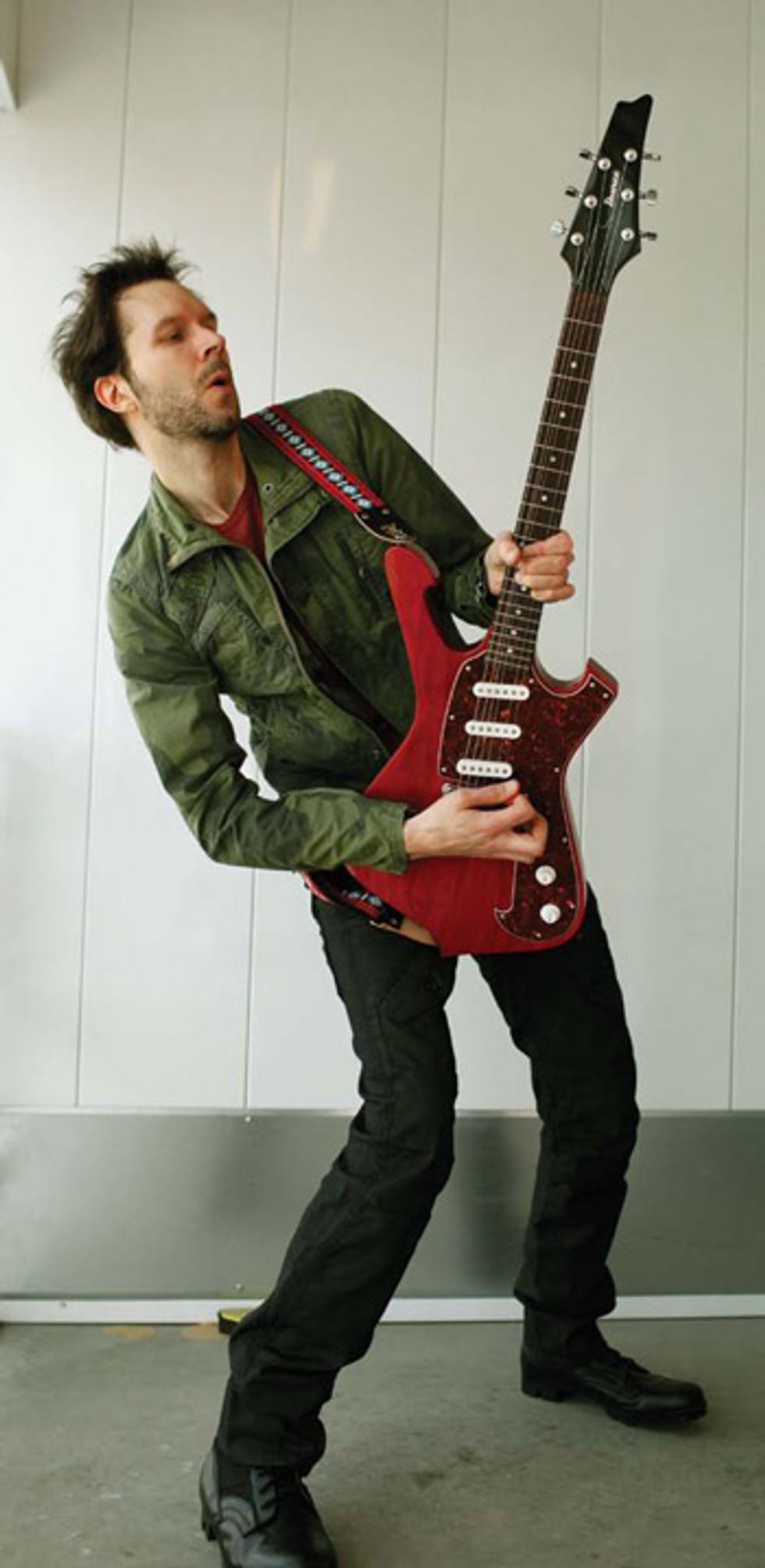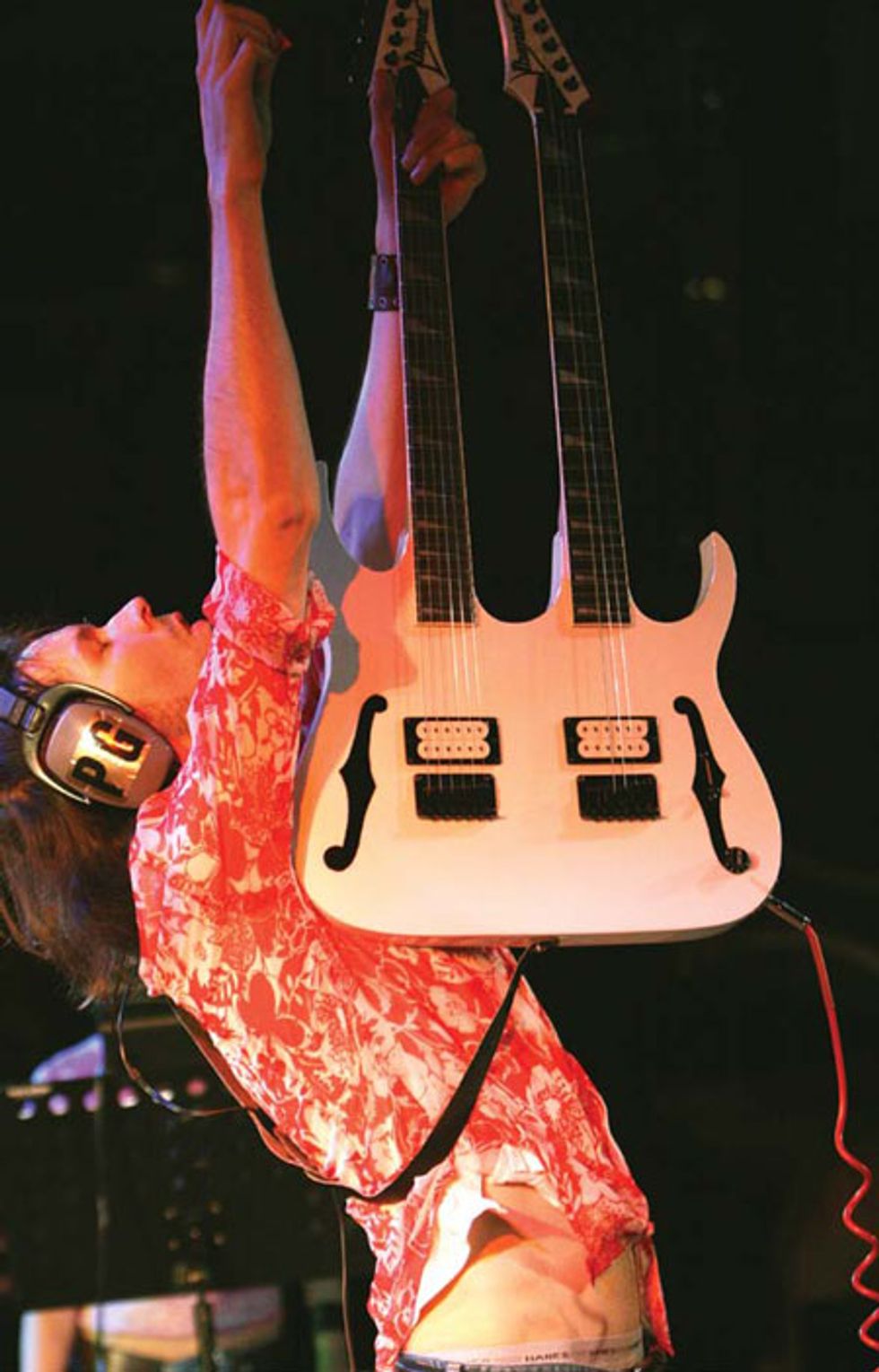single-coils. Controls include a Volume knob, a Tone knob that only affects the bridge pickup,
and a 5-way pickup selector. Photo by James Chiang
The term “shredder” gets thrown around willy-nilly as if it proffers a canned, easily digestible taste of what the guitarist behind the label is all about musically. And often it’s used in derision—an efficient, two-syllable means of writing off a player without listening to a note of their supposed wanking. That’s B.S.
Yeah, all of us can think of a zillion players to back up the disingenuous argument. Guys that serve up unmelodic, tinny-toned, groove-starved indulgence as if they were afraid the universe’s supply of notes is finite and must be used up as quickly as possible before someone else steals them. But the conveniently overlooked flaw in this hypothesis, of course, is that we can all name a zillion examples of utter lameness in any genre under the sun.
Naturally, this levelheaded, well-reasoned point is never going to eradicate the tendency of some players to dismiss whole swaths of art because of tenuous mental associations. For them, pointy-headstocked guitars, having worn spandex 20+ years ago, and the ability to sweep-pick like a badass will always equate to “uncool shred.”
But the rest of us who sit back and listen without prejudging will always be rewarded. And Paul Gilbert—a notoriously gifted jangle pop songwriter who can also melt your mind with string-skipping neoclassical licks—is one of those guys standing at the ready to demolish our preconceptions like Godzilla squashing skyscrapers and sending small-minded players scurrying for cover before his mind-boggling might. At least that’s what one listen to the famous shredmeister’s new instrumental album, Fuzz Universe, reveals. Maybe that’s why Gilbert chose such larger-than-life artwork for the new album’s cover.
We recently spoke to Gilbert as he toured the US doing clinics and workshops before heading off to tour Japan. As always, he was funny and articulate as we discussed everything from his favorite Beatles chords to how his tones have changed over the years and how his hearing loss affects his performing and recording.
You’re a huge fan of the Beatles and all sorts of jangle pop. How does that affect your writing and performing for an all-instrumental album like Fuzz Universe? Is the instrumental format liberating or constraining—or both?
The Beatles are kind of my musical DNA. If I could sing like them, write like them, and make girls jump up and down and scream like they did, then I would never have to play instrumental music at all. But for some reason, playing athletic things on the guitar always came easier to me. So I try to do that in a musical way that even a Beatles fan like me could listen to. More specifically, I try to learn lots of chords from ‘60s and ‘70s pop songs and use them as the foundation for my melodies. On this album, I used a lot of min7b5 and 7sus4 chords. I love the sound of those chords, and I feel they are terribly underused in heavy rock. I felt it was my mission to bring up the average.
Also, it’s funny you mention the Beatles, because when I was working on the chorus for the opening track, “Fuzz Universe,” I was suddenly inspired with a chord progression and melody. I ran into my studio to record it while it was still in my head. First I recorded the chords, then I started overdubbing the melody, and—damn—I realized I had just written the bridge to a very famous Beatles song. I ended up changing it with a couple of chord substitutions and a totally different melody of my own, but you can still sing the Beatles melody over the top and it fits perfectly. I’ll let you guess which song it is.
That song begins with this cyclical, sinewy lead that reminds me of the licks you were teaching at clinics back in the ‘80s. There’s also a prominent flanger sound. Is that your signature Ibanez AF2 Airplane Flanger engaged on most of the song?
 |
If I’m not mistaken, the Airplane Flanger was based on the old ADA units, right? What tweaks to that design did you request?
The old ADA flangers were cool because you could turn one of the knobs all the way up and it would take over your whole guitar sound with this ferocious, electronic dive bomb. I asked Ibanez to make a pedal that would give me something like that, but with a second flange channel that I could adjust for more normal flange sounds. The normal side will also go crazy if you crank it up, so sometimes I can’t resist and I just toggle between the two crazy sides.
You get a ton of tones on “Olympic” alone—ringing, semi-clean intro licks, crunchy Vox-style rhythms, modulated arpeggios, milkshake-thick power chords, and then the phased, slippery leads and straight-ahead arpeggiated solos. In your pre-Mr. Big days, you were using an ADA MP-1 tube rack preamp, which had something like 128 presets. How do you approach tone selection now? Do you have a standard set of, say, 10 or 15 go-to tones, or do you just dial things up from scratch with each song?
I used the same amp and just a few guitars for almost the whole record. I mostly use pedals to change sounds. I saw Frank Marino play a club show a few years ago, and he had one of best guitar sounds I’ve heard in a long time. I used to listen to Mahogany Rush Live all the time when I was a kid, and Frank was legendary for having this giant pedalboard. I still love the way pedals sound in front of an amp, so that’s what I do. Some of my new pedal discoveries on this album were two overdrives by Majik Box. One is a Venom Boost, and the other one was a prototype with no name. I used them for the whole record, so they’re going to put them together into one box and make a new signature pedal for me called the Fuzz Universe. It’s a good name, I think!
I also used a HomeBrew Electronics UFO fuzz octave pedal, a HomeBrew THC chorus, a HomeBrew CPR compressor and Detox EQ for clean stuff, a Cry Baby 535Q wah, and, of course, the Phase 90 and Airplane Flanger. And lots of Velcro to hold it all together.
The beginning of “Blue Orpheus” sounds a bit like a Brian May tribute. Did you intend it that way? Also, the main verse guitar tones seem to have more of a fusion feel than I’ve heard in your past work. What was the inspiration there?
That’s a Todd Rundgren song that was originally all vocals. I tried to stay true to Todd’s arrangement, but I used guitars instead of voices. And I’m happy anytime I can sound like Brian May. The verse was challenging for me, because I wanted to use the cleanest sound possible but still have sustain. I ended up using my HomeBrew compressor as well as a Tube-Tech compressor after the mic preamp to get enough sustain to feel good.
“Will My Screen Door Stop Neptune” begins with a badass line that sounds a little like what Ralph Macchio’s character played in the duel at the end of Crossroads. And then you rip out some jaw-dropping muted licks that sound like they might be hybrid picked. Are you using your picking-hand fingers there at all, or is it all pick?
I’m not so familiar with that movie, but I’ve heard great things about it. My inspiration for this one is kind of unusual. I wanted to write a song with my favorite tempo. What is my favorite tempo? “Neon Knights” by Black Sabbath, with Ronnie James Dio on vocals, of course! So I listened to that song and tapped away at my drum machine to get a number for the tempo. Then I played some drums at that tempo, recorded it, and switched to guitar. I jammed along and came up with that riff. Then I listened to it and realized that my riff would sound better if the drums were played in half time. So, in the end, I discarded my tempo—or at least cut it in half—but I got a good riff out of it. And hopefully the spirit of Ronnie James Dio resides in the music just a little bit.
I think the muted licks you’re talking about are probably the augmented arpeggios—and I was hoping someone would notice those. Augmented is another great chord that the Beatles and ELO used to make pop songs. I never had a good fingering for playing them quickly, but the Bach violin piece I did on this record [“Bach Partita in Dm”] inspired some new arpeggio techniques that opened a lot of doors for me, including this one. It’s all picking, hammer-ons, and pull-offs, but the position shifts and stretches are an adventure.
 |
The twangy rhythms on “Batter Up” sound a little like Bill Kirchen or another Tele master, while the lead sounds a bit Satriani-esque. What inspired that?
I was doing a clinic in Sicily and the audience demanded an encore. I had played all the songs I had prepared, so in a desperate attempt to entertain I went back onstage and did a drum solo. Someone caught it on video and posted it on YouTube [search for “Paul Gilbert concede il bis... sulla batteria!!!”]. When I watched it, I realized that this was the best drum solo I’ve ever done. So I wanted to write a song around it—sort of my own version of “Wipe Out.” In studio, I thought it would be better to let a real drummer take the solos, and Jeff Bowders did a stunning job. When I listen to the song now, though, I almost wish that I had shortened the arrangement and left out the guitar solos. My favorite part is the twangy guitar and the drums. I’m hoping to teach my drummer how to play the guitar part, and then I can do the drum solo live. I like playing guitar, but drums are more fun than anything.
What did you use for the Leslie-flavored chord stabs in “Mantra the Lawn”?
That was a Hughes & Kettner Rotosphere pedal.
What’s your favorite guitar part on the new album—and why?
I really like “Fuzz Universe.” It’s very representative of the metal side of my guitar playing, but I think the song and playing are my best yet in that style. I love so many parts in “Olympic,” too: It has arpeggio ideas that I’ve never done before over a chord progression I’ve never done before. I think “Mantra the Lawn” has some of my best phrasing and vibrato, and “Will My Screen Door Stop Neptune” has a super-fast solo over chord changes where I nailed it in the first take. It’s actually the solo from the demo. I don’t know if I’ll ever be able to play it that well again. I haven’t tried because I never did a second take!
What did you use to record the album?
I used a Marshall Vintage Modern head into a THD Hot Plate and then into a Randall Isolation cabinet with a 12" Celestion. I used two mics, a Shure SM57 and a Royer ribbon mic, plugged into two AMEK System 9098 mic preamps and then into Pro Tools.
Were there any unusual aspects about how you wrote for or recorded this record?
I think the most unusual thing is that a 43-year-old guy who listens to Johnny Cash, Silvius Weiss lute music, Bulgarian women’s vocal choirs, B.B. King, Melody Gardot, Justin Currie, and the Bee Gees for inspiration ends up with an album of screaming rock guitar. It’s hard to shake off those teenage years of Van Halen, Rush, Randy Rhoads, Robin Trower, Pat Travers, Frank Marino, Gary Moore, and the Ramones. [Laughs.]
You’re wearing headphones live both to protect your hearing and as monitors, right? How severe is your hearing loss, and how does it complicate the process of selecting tones, getting appropriate levels, mixing, etc.?
My hearing loss doesn’t bother me when I’m playing music. I can hear tones easily, I can feel the guitar because I’m playing it, and it’s rock ’n’ roll, so it’s loud anyway. I really notice my hearing loss when I’m talking to people. It’s hard for me to differentiate consonants, so the words “Tim,” “tin,” “thin,” and “him” all sound the same to me unless the person is talking pretty loud. It really varies from person to person. My wife speaks very clearly, so when I’m around her I feel like my hearing is close to normal. But did you ever see that movie with Nicole Kidman called The Hours? It’s about two hours of women whispering to each other. I didn’t have a fighting chance in that one! I saw it on an airplane where there were engines to compete with and no subtitles. Through no fault of her own, I will be angry at Nicole Kidman for a long time to come. Speak up, woman! [Laughs.]
 |
You’ve done a lot of clinics and seminars over the years—what are some of the most common questions you get?
I hope that I can answer people’s questions and give them something useful in my answers, but I think the most valuable communication between musicians happens musically. Whenever I get the chance, I go to Musicians Institute to do private lessons. This gives me a chance to jam with students and listen to what they’re saying with their guitars. It becomes very obvious what they need to work on without them having to ask anything. And it’s almost always the same thing that needs work: Timing and endings. How to play in time, with a tempo, and how to end a solo so the listener knows that the solo ends right here. We’re all guitar players and we all struggle with the same challenges, so I can’t help but turn the critical eye back on myself and try to improve my own timing and endings. This is why I love to teach—I learn more than anyone!
What’s the biggest misconception you think guitarists on the whole have about “shredders”?
I don’t know when that term will stop giving me the creeps. Somehow it makes me think of a person trying to pick as fast as they possibly can, with their left hand out of sync, lots of delay to cover up the flaws, total disregard for the song’s tempo, and vibrato done out of obligation rather than love of the sound. This is the grumpy old man in me. “You kids—get out of my yard!” I hope it’s my misconception and that shred will come to mean guitar virtuosity that rivals the legacy of Itzhak Perlman, Glenn Gould, and Oscar Peterson. Anyway, regardless of what terms people might use, I hope that guitarists who play fast will invest enough love and practice to make their playing world-class, listenable, and super shredifying. And then do some spine-tingling vibrato followed by three big notes that say “The solo ends right here.” It’s a worthy goal.
Paul Gilbert's Gearbox
Guitars
Four Ibanez PGMFRM1 Fireman models—one in korina, a red version, and a light-blue one nicknamed “Kikusui Sake,” all with new DiMarzio hum-cancelling single-coils (“I used them for most of the album . . . I’m not sure what they are called yet, but they sound killer”), plywood Ibanez PGM800 prototype
Amps
Marshall 2266c Vintage Modern 50-watt 2x12 combo, Marshall 2061X head, vintage Fender Princeton Reverb (for the surf sound on “Batter Up”), THD Hot Plate, Randall Isolation cab with 12” Celestion
Pedals
Majik Box Venom Boost, Majik Box prototype fuzz, HomeBrew Electronics UFO, HomeBrew THC, HomeBrew CPR, HomeBrew Detox EQ, Cry Baby 535Q wah, script-logo MXR Phase 90, Ibanez Paul Gilbert Signature AF2 Airplane Flanger, Hughes & Kettner Rotosphere
Strings and Picks
Ernie Ball RPS strings (.010–.046), Dunlop Tortex .60 mm picks
Miscellaneous
Bullet coiled cable (guitar to pedalboard), straight DiMarzio cable (pedalboard to amp), Voodoo Lab Pedal Power 2 Plus, Shure SM57 and Royer ribbon mics, two AMEK System 9098 mic preamps, Direct Sound Extreme Isolation EX-29 headphones












![Rig Rundown: Russian Circles’ Mike Sullivan [2025]](https://www.premierguitar.com/media-library/youtube.jpg?id=62303631&width=1245&height=700&quality=70&coordinates=0%2C0%2C0%2C0)












![Rig Rundown: AFI [2025]](https://www.premierguitar.com/media-library/youtube.jpg?id=62064741&width=1245&height=700&quality=70&coordinates=0%2C0%2C0%2C0)




















 Zach loves his Sovtek Mig 60 head, which he plays through a cab he built himself at a pipe-organ shop in Denver. Every glue joint is lined with thin leather for maximum air tightness, and it’s stocked with Celestion G12M Greenback speakers.
Zach loves his Sovtek Mig 60 head, which he plays through a cab he built himself at a pipe-organ shop in Denver. Every glue joint is lined with thin leather for maximum air tightness, and it’s stocked with Celestion G12M Greenback speakers.











